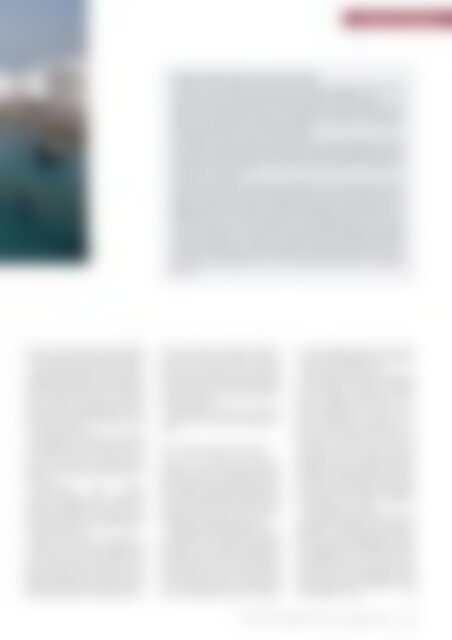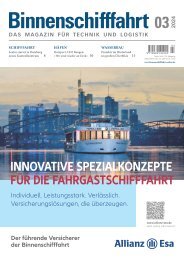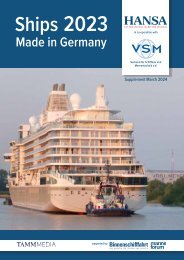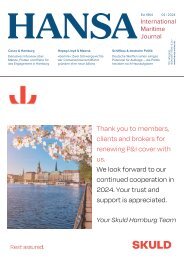HANSA 01-2019
Speditionen | Windantrieb | Tanker-Report | RAVE | Bilanz deutscher Häfen | Hyperloop | Fokus Bunker & Schmierstoffe | Shortsea | dship | Hansa Heavy Lift | Review HANSA-Forum
Speditionen | Windantrieb | Tanker-Report | RAVE | Bilanz deutscher Häfen | Hyperloop | Fokus Bunker & Schmierstoffe | Shortsea | dship | Hansa Heavy Lift | Review HANSA-Forum
Erfolgreiche ePaper selbst erstellen
Machen Sie aus Ihren PDF Publikationen ein blätterbares Flipbook mit unserer einzigartigen Google optimierten e-Paper Software.
Schifffahrt | Shipping<br />
© Vopak<br />
Singapore imposes ban on open-loop scrubbers<br />
A decision by the Singapore Port Authority should deter shipping: The island state<br />
wants to ban the use of so-called open-loop scrubbers in the port area.<br />
The pros and cons of scrubbers are currently being hotly debated, opponents and<br />
supporters are fighting each other with arguments as to whether flue gas scrubbers<br />
are the right answer to the IMO’s new sulphur requirements. Now Singapore<br />
is literally pouring oil into the smouldering fire.<br />
The Southeast Asian island state wants to ban open-loop scrubbers from its port<br />
area. These are open systems that discharge the wastewater (sludge) back into the<br />
sea after the purification process with seawater. Ships equipped with these systems<br />
would have to use low-sulphur fuel instead. But this more than challenges the<br />
investment in the plants.<br />
Scrubbers cost between 2 and $8 mill. $, depending on ship type and size. Shipowners<br />
who invest in such plants could continue to use heavy fuel oil (HFO, 3.5%<br />
sulphur content) after 1 January 2020 instead of the new fuels with a maximum<br />
sulphur content of 0.5%. The price difference should be at least 250 $ per tonne.<br />
If Singapore were to implement its plan, this advantage would be lost in one of<br />
the most important ports and bunker sites for global shipping. The discharge<br />
of the washing water would then be prohibited. Ships equipped with hybrid<br />
scrubbers would have to switch to the closed cycle and use all other IMO-compliant<br />
fuels. The regulation has already been adopted and will enter into force<br />
on 1 January 2020, Andrew Tan, CO of the port authority MPA, is quoted by<br />
Reuters.<br />
tinued use of high sulphur fuel oil (HFO)<br />
in conjunction with a scrubber and LNG.<br />
To meet the demands for 0.5% sulphur<br />
compliant fuels and marine gas oil, ExxonMobil<br />
has undertaken a 1bn. $ upgrade<br />
of its Antwerp plant, and is reviewing a<br />
major upgrade in its Singapore and UK<br />
refineries. ExxonMobil’s Singapore refinery<br />
is the company’s largest, processing<br />
592,000 barrels a day.<br />
The company said: »We have already<br />
made significant investments at a number<br />
of other refineries around the world<br />
in order to increase our production capacity<br />
of cleaner fuels with lower sulphur<br />
content.«<br />
ExxonMobil’s 2020 compliant<br />
0.5% sulphur fuels range from<br />
RMD80 to RMG380 with a density of<br />
between 900 and 970 at 15 degrees Celsius,<br />
and catalytic fine content meeting ISO<br />
8217:2<strong>01</strong>7 parameters.<br />
Shell, on its part, has completed initial<br />
trials for its very-low sulphur fuel<br />
oil (VLSFO), which has sulphur content<br />
of 0.5%. Ship operators who wish to test<br />
Shell’s product may purchase the fuel in<br />
Rotterdam, Singapore and New Orleans.<br />
Shell’s global sales and marketing manager<br />
for marine fuels, Melissa Williams,<br />
said: »We’re giving customers an opportunity<br />
to test the new fuel to become<br />
more familiar with how the fuel performs<br />
in their vessels. We will work with end<br />
users during the trials to assist them in<br />
handling VLSFO.«<br />
The Anglo-Dutch oil major said that<br />
VLSFO will be available in Singapore by<br />
2020.<br />
Part of Belt and Road initiative<br />
Chinese oil refining group Sinopec,<br />
which has a joint venture with BP in Singapore,<br />
will also start supplying compliant<br />
LSFO from August 2<strong>01</strong>9. Sinopec Fuel<br />
Oil Company’s general manager Liu Zurong<br />
said: »Sinopec plans to sell LSFO in<br />
Singapore and some countries that are<br />
part of the Belt and Road initiative.«<br />
Although the IMO’s regulations do not<br />
take effect until 1 January 2020, China<br />
has gone one step ahead by implementing<br />
emission control areas in the Yangtze<br />
River Delta from 1 October 2<strong>01</strong>8. ECAs<br />
in the Pearl River Delta and Bohai Rim<br />
will be implemented on 1 January 2<strong>01</strong>9.<br />
The measures gave Sinopec the impetus<br />
to start producing LSFO and the refiner<br />
has installed desulfurization units in<br />
some of its coastal refineries.<br />
Seoul-based petroleum refining firm<br />
SK Innovation, the parent company<br />
of SK Trading International, is planning<br />
to complete construction of a 1 tr.<br />
KRW (896.8 mill. $) Vacuum Residue<br />
Desulfurisation (VRD) Unit in Ulsan<br />
by July 2020 to produce low sulphur<br />
fuel oil (LSFO). The VRD unit,<br />
the largest capacity among refiners in<br />
South Korea, will be able to produce<br />
38,000 barrels of low sulphur fuel per day.<br />
Through its trading subsidiary, SK Trading<br />
International, SK Innovation expects<br />
to sell more LSFO material in Singapore<br />
to compensate for reduced margins of<br />
LSFO production at Ulsan.<br />
SK Trading International has been<br />
blending 0.1% sulphur LSFO product at<br />
Singapore since 2<strong>01</strong>5, using an oil tanker,<br />
there, they said. SK Trading International<br />
is targeting to sell 100,000 t of LSFO<br />
at Singapore this year, an 85% increase<br />
from sales volume of 54,000 t in 2<strong>01</strong>7. The<br />
company forecasts the Singapore LSFO<br />
market to grow 30% to 190,000 t in 2<strong>01</strong>8,<br />
from 140,000 t in 2<strong>01</strong>7. <br />
n<br />
<strong>HANSA</strong> International Maritime Journal – 156. Jahrgang – 2<strong>01</strong>9 – Nr. 1 51


















